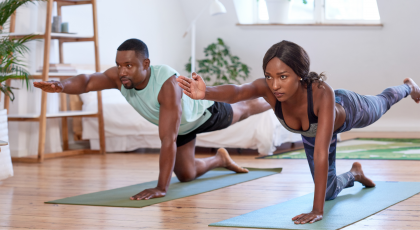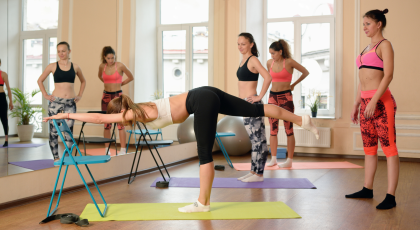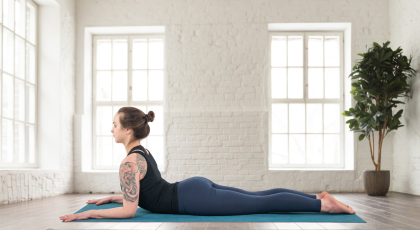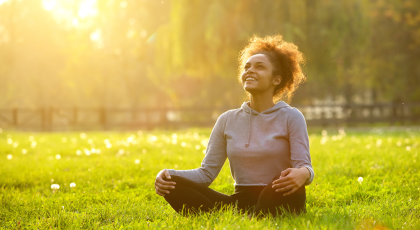View basket (0 items $0.00)

Yoga for Arthritis - 8 Tips to Help You Relieve Symptoms and Stay Active
After years of teaching high-impact aerobics, I found myself in the office of an orthopedic surgeon discussing knee surgery. I was frustrated and scared and told my doctor it wasn’t fair because I’d always been active and exercised.
“Well dear, your knees aren’t as young as they used to be,” he said. “Arthritis is beginning to set in.”
What? I think my doctor just called me old. And said I have arthritis.
I was 43 that day in the doctor’s office. How could I possibly have arthritis? Well, I did.
Activity with Osteoarthritis
According to the Centers for Disease Control, the onset of osteoarthritis—the painful degeneration of joint cartilage—is gradual and usually begins after the age of 40.
Thankfully, yoga has allowed me to stay active and relatively pain free with some minimal modifications.
The causes of osteoarthritis include genetic factors, old injuries, unhealthy postural habits, even repetitive work movements. More than 52 million people in the United States are affected by arthritis, making it the most common disability.
A New York Times article by Jane E. Brody, Keep Moving to Stay a Step Ahead of Arthritis, discusses how the pain of osteoarthritis leads to decreased physical activity.
Brody reports on several recent studies, which convincingly demonstrate that decreasing physical activity to deal with the pain of arthritis is the very last thing you want to do.
In a 10-year study of more than 2,000 men and women with arthritic knees, Jungwha Lee and her colleagues found that fewer than 10 percent met the national guidelines of doing 150 minutes a week of moderate physical activity. But if they improved their physical activity, “they functioned better and had less disability,” said Dr. Lee, a biostatistician at Northwestern University Feinberg School of Medicine in Chicago.
As adults become more sedentary, their quality of life diminishes and their physical health declines even further, Brody notes.
In a study that Pamela A. Semanik, Dr. Lee and colleagues published in the American Journal of Public Health, the more time people with arthritis spent in sedentary behavior, the greater their loss of function over a period of two years. “They went from bad to worse,” she said in an interview.
“People control their pain by doing less physical activity,” Dr. Lee said. “But being more active can delay the functional decline that accompanies aging. Any activity is better than being sedentary.”
Brody encourages finding alternative forms of movement to replace former high-impact activities such as running or group exercise classes. She suggests walking, swimming, water walking and cycling as activities that are softer on arthritic joints yet still provide cardiovascular benefits.
Osteoarthritis and Yoga
In my experience of teaching seniors' yoga classes, I’ve found yoga to be extremely helpful in reducing arthritic symptoms. Maintaining functional fitness, simple things like climbing stairs or opening a jar, allow someone with arthritis to hold on to their independence.
Osteoarthritis is progressive. Therefore, movement is crucial to the treatment of arthritis and to delay its progression. The slow, gentle movements of yoga, combined with the ability to easily modify the asanas, make yoga an ideal exercise for arthritis patients. The fluid movements of yoga also help stabilize or even increase range of motion of the commonly affected joints.
Non-arthritic joints need to move through their full range of motion and bear weight to remain healthy. Arthritic joints are no exception.
In his book Yoga as Medicine, Dr. Timothy McCall says yoga is ideally suited to handle the long-term effects of dysfunctional movement patterns, bone misalignments, lack of body awareness and poor posture that can lead to osteoarthritis. He says the asanas take the joints through a wide range of motion, effectively resetting the negative body patterns accumulated through the years.
When joints move safely, the surrounding cartilage and bones become lubricated with synovial fluid. Think of synovial fluid as WD-40 for your joints. When cartilage is well lubricated, the joint surfaces glide smoothly across each other, reducing wear and tear, therefore increasing range of motion and decreasing pain.
The stress relief aspects of yoga are also beneficial to those with arthritis. When people become stressed they tend to tighten their muscles by hunching shoulders or making fists with their hands. The pain from the tight muscles increases the arthritic pain, leading to more stress and distress. It’s a vicious cycle that can lead to further decreased physical movement and deeper depression.
Meditation and pranayama exercises relax the muscles and encourage the actions of the parasympathetic nervous system, responsible for lowering blood pressure and calming the mind and body. Meditation has been proven to help those dealing with chronic pain. A 2011 Wake Forest University study found that participants had a 40 percent reduction in pain intensity ratings during meditation.
8 Ways to Relieve Arthiric Pain with Yoga
To get the most arthritic pain relief from your yoga practice, consider these tips:
-
Find a certified yoga teacher or yoga therapist familiar with osteoarthritis.
-
Modify the asanas to fit your body. Use bolsters, blankets, blocks, straps or even a chair to make yoga more accessible.
-
Know when to say no. Just because you were pain free yesterday doesn’t mean you can practice flow vinyasas today. Begin each practice with tuning in to your body and noticing what you are feeling.
-
A Restorative yoga class might be more beneficial than a traditional vinyasa class. Try both depending on your pain level.
-
If arthritic pain is hindering your daily life or is becoming less manageable, consider a chair-based yoga class that doesn’t involve floor work.
-
Incorporate small motor movements into your practice. Simple exercises like circling one finger at a time, making gentle fists then opening wide or touching each finger to your thumb will keep the stiffness out of arthritic hands making it easier to pick up buttons or open jars.
-
Initiate a home meditation practice to help relieve stress and decrease pain. There’s no rule that says you have to sit on the floor to meditate. If a chair or even the bed is more comfortable that’s fine. Doing the meditation is more important than where you meditate.
-
If you are new to meditation, try an online meditation video or guided imagery DVD. YogaUOnline has a wide assortment of classes for every level on their premium practice channel. They also often offer free downloads on their site.
Osteoarthritis is a chronic and progressive condition. But with the right care and physical activity it doesn’t have to be debilitating.
Study with YogaUOnline and Dr. Tim McCall - Yoga as Medicine: The New Paradigm for Health.
A YogaUOnline interview on yoga and arthritis with yoga therapists, Dr Loren Fishman and Ellen Saltonstall: Yoga for Arthritis-Can Yoga Help Preserve Freedom of Movement?
 Jennifer Williams-Fields E-RYT 200 is passionate about writing, yoga, traveling, public speaking and being a fabulous single momma to six super kids. Doing it all at one time, however, is her great struggle. She has been teaching yoga since 2005 and writing since she first picked up a crayon. Although her life is a sort of organized chaos, she loves every minute of the craziness and is grateful for all she’s learned along the way. Her first book "Creating A Joyful Life: The Lessons I Learned From Yoga and My Mom" is now available on Amazon. She has had her essays featured on Yahoo! and Dr. Oz The Good Life. She is a regular writer for Elephant Journal Magazine, YourTango and YogaUOnline. See more from Jennifer at jenniferwilliamsfields.com
Jennifer Williams-Fields E-RYT 200 is passionate about writing, yoga, traveling, public speaking and being a fabulous single momma to six super kids. Doing it all at one time, however, is her great struggle. She has been teaching yoga since 2005 and writing since she first picked up a crayon. Although her life is a sort of organized chaos, she loves every minute of the craziness and is grateful for all she’s learned along the way. Her first book "Creating A Joyful Life: The Lessons I Learned From Yoga and My Mom" is now available on Amazon. She has had her essays featured on Yahoo! and Dr. Oz The Good Life. She is a regular writer for Elephant Journal Magazine, YourTango and YogaUOnline. See more from Jennifer at jenniferwilliamsfields.com
Featured Courses








